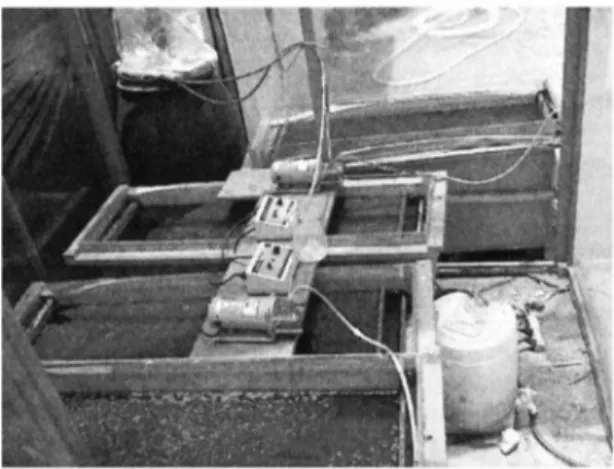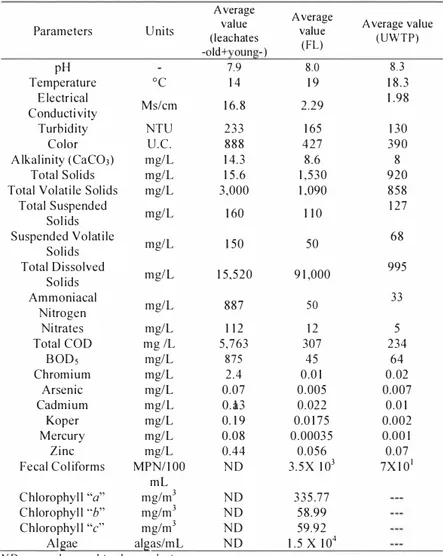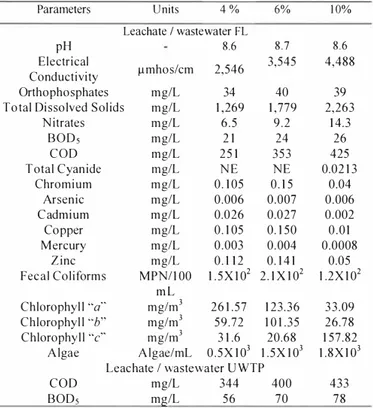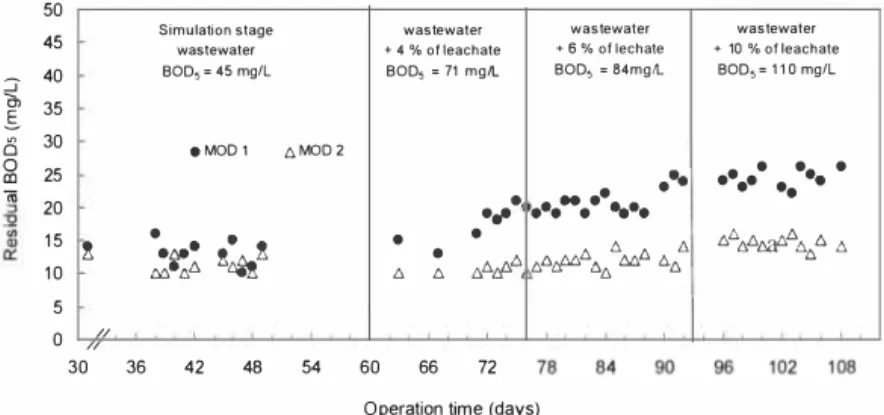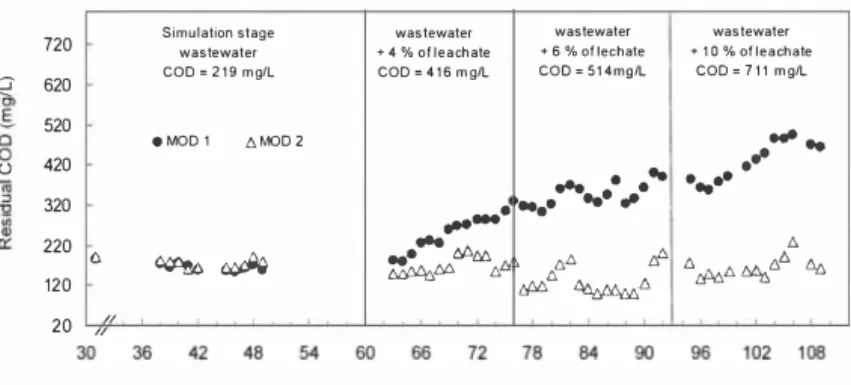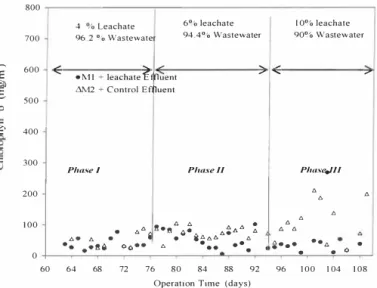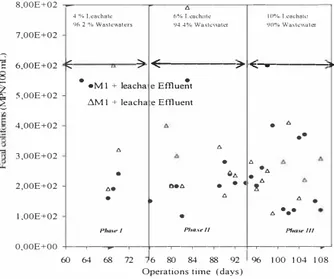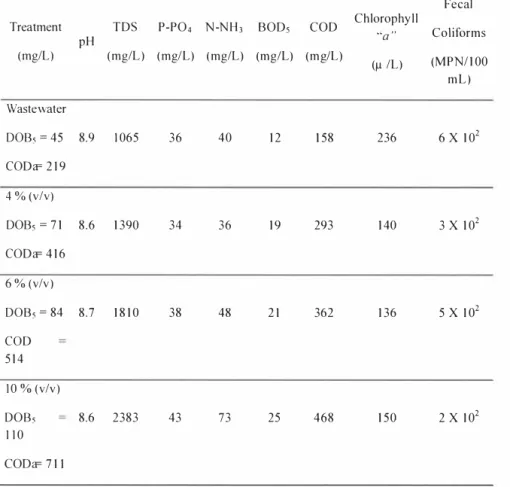35
PILOT-SCALE MODELS OF TREATMENT OF
LANDFILL LEACHATES COMBINED WITH
URBAN W ASTEW ATERS IN
A FACULTATIVE LAGOON
Ma. Teresa Orta-de- Velasquez
Ma. Neftali Rojas- Valencia
Ignacio Monje-Ramirez
Isaura Yanez Noguez.
National A utonomous University of Mexico, Mexico
ABSTRACTThis study set out to determ ine the potential for treating leachates in combination with wastewater at Facultative Lagoons, a device normally used for treating raw wastewaters. Pilot-scale models were used to simulate leachate treatment and disposal in a Facultative Lagoon (FL), combining 2.4 L/hr of raw wastewater with a leachate m ixture (comprising both young and old leachates), in concentrations of 4%, 6%, and 1 0% (v/v). The solution of leachate mixture in raw wastewater was then fed into the two pilot-scale models ( M I and M2). The following parameters: concentration of algae; chlorophyl l a, b and c; faecal coliforms (FC); and heavy metals, were analyzed in all the three component stages: the unmixed wastewater; the old and young leachate mixture; and the combined wastewater leachate mixture.
As a 1 0% dilution was found not to impede correct functioning of the Model Facultative Lagoon, the same concentration was tried out using urban wastewaters from the University Wastewater Treatment Plant (UWTP).
Interval values of BODs and COD in the wastewater and in the leachate mixture were 45-875 mg/L and 307-5,763 mg/L respectively, and results showed that a I 0% concentration of leachates combined with wastewater does not upset the system of biological treatment. None of the mixtures affected the population of algae. Maximum removal efficiency of BOD5 was 75%, and 35% for COD, therefore leaving a BOD5 level of less than 25 mg/L in the efflouent from the FL. The removal of BOD5 and COD from the UWTP was greater still, 86% and 64%, respectively. FC and heavy metal concentrationso: As (0.007 mg/L), Cd (0.02 mg/L), Cu (<0.0 l mg/L), Cr (0.04 mg/L), Hg (o<0.00027 mg/L), Ni (0. 1 5 mg/L), Pb (0.098 mg/L), CN (0.02 1 3 mg/L) and Zn (0.05 mg/L), were all below the maximums establ ished by the Mexican Federal Regulation for Reuse of Wastewater in Agricultural Irrigation (NOMECOL00 1
-1996). KEYWORDS
Pilot-Scale Models; Landfill leachates; wastewaters; facultative lagoon.
KALMAR, SWEDEN, November 26-28, 2007 1 INTRODUCTION
Every day the Bordo Poniente Sanitary Landfill receives approximately 1 2,000 tons of urban waste originating from Mexico City. In this and any landfill, infiltration, precipitation and migration of water through the landfill produces a leachate containing varying quantities of undesirable, even toxic, organic and inorganic substances [ I ].
The leachates generated in a landfill are mainly of two typesa: I ) Old leachates (older than five years) the physical-chemical characteristics of which give a Biochemical Oxygen Demand/Chemical Oxygen Demand (BOD5/COD) ratio of less than 0. 1 , indicating the leachate is stabilized; and 2) Young leachates (in cells less than one year old) the BODs/COD ratio of which is 0.35, indicating the leachate is biodegradable and responsive to biological treatment [2]. Given that leachates are produced in large quantities and are highly toxic, they must be treated. The toxicity requires that studies must first be made as to the rates at which leachates can be poured directly into any biological treatment system without causing perceptible alterations either to the system itself or to the environment.
Some bibliographical reports indicate that leachates with a COD of I 0,000 mg/L can be treated in a 5% solution by volume of leachate to wastewater, without causing negative effects to the treatment processes or to effluent quality [3]. Another study treated leachates with a COD of 37.67 mg/L and a BOD5 of 1 3.82 mg/L, in a system of activated sludge with a leachate to wastewater proportion of 1 .5% (v/v). The result was a highly efficient removal of biodegradable organic material and ammoniacal nitrogen [4].
Referring to a landfill in Quebec, Zaloum and Abbott, ( 1 997) reported that the Facultative Lagoons where wastewaters are treated are also used to treat leachates from the sanitary landfills in the area. Raw leachates accumulate at the base of the landfills from autumn to late spring, and are treated in the Lagoons during the summer months. Semi-continuous discharge from the treatment system at the Facultative Lagoons then takes place from early spring to late autumn, when the treated leachates meet Regulations for solid waste [5].
Using a UASB pilot-scale reactor, Fueyo et al. (2003) carried out an anaerobic degradation of leachates mixed in different proportions with urban wastewater. The treatment systems applied are the same as those used for wastewater, but the characteristics of each leachate need to be consiadered separately [6].
In many cases Facultative Lagoons are used as a pre-treatment step prior to some form of biological treatment in a municipal facility. However, although a considerable amount of research has been carried out into the biological treatment of leachates, few real-scale studies on the utilization of Lagoons for leachate treatment have been reported in the literature [7]. Others studies have evaluated the quality of leachates in landfills of different ages, but the reported ranges of variation of all the leachate components are partaicularly wide, and the long term trends are sometimes contradictory [7, 8].
The study being reported here set out to determine the potential for treating leachates in combination with wastewater at Facultative Lagoons, a device normally used for treating wastewaters alone. Pilot-scale models were used to simulate leachate treatment and disposal; and treatment efficiency was assessed by analyzing the concentrations of algae and of chlorophyll a, b and c, the parameters used to measure effluent control and quality.
2 MATERIA LS AND METHODS 2.1 Design of the pilot-scale model
Pilot-scale models were used to simulate leachate treatment and disposal in a Facultative Lagoon (FL), combining 2.4 L/hr of raw wastewater with a leachate mixture (comprising both young and old leachates), in concentrations of 4%, 6%, and I 0% (v/v). The solution of leachate mixture in raw wastewater was then fed into the two pilot-scale models (M I and M2). The following parameters: algae concentration; chlorophyll a, b and c; faecal coliforms (FC); and heavy metals, were analyzed in all the three component stages: the unmixed wastewater; the mixture of old and young leachates; and the combined wastewater-leachate mixture.
The design of the model was based on the control of a laminar flow regimen. Each tank had drains that permitted the entrance and exit of water without provoking turbulence. Two identical models were constructed ( M I and M2): leachates were added to modeal M I , whilst model M2 served as the control receiving only FL wastewater. Both models where the two treatments were carried out had tanks of 200 L capacity, and each was fitted with a system of continuous agitation. Figure I shows the characteristics of the pilot-scale modeal as it was used during the study. To monitor progress, every 48 hours throughout the experiment samples of wastewater were taken for laboratory analysis from the Facultative Lagoons that lie about 1 .5 km from Texcoco Lake. Samples of leachate from the Bordo Poniente Landfill were also taken. Each leachate sample was constituted in the following way. Samples were taken from 1 2 points distributed around the Landfill. These 1 2 samples were then mixed together giving one sample representative of the entire Landfill. Each sample-taking exercise was carried out in triplicate.
Figure I. Characteristics of the pilot-scale model.
The pilot-scale reactors were first filled with wastewater from the Churubusco Channel and inoculated with 60 L containing algae and sludge obtained from the Texcoco wastewater treatment plant. Fresh untreated wastewater was then fed in, ensuring the BODs and COD remained at 45 mg/L and 307 mg/L, respectively. The inflow was maintained at 2.4 L/hr, 37
determ ined beforehand to be the ideal now volume. Frequent monitoring was carried out to ensure these parameters were maintained. Over the experimental period of 30-60 days, the percentage of BOD5 removal was found to remain constant. The reactors were therefore considered stabilized, and the process moved on to the next step.
Leachate was collected from the lateral channels alongside each macro-cell of the Bordo Poniente Landfill, and a leachate m ixture was created taking two parts by volume of stabilized leachate (old) with an average BOD5 of 1 60 mg/L, plus one part by volume of young leachate with an average BOD5 of 680 mg/L. This leachate mixture was progressively introduced into the MI model, starting with 4%, followed by 6% and then I 0% by volume (v/v) of leachate to wastewater in phases I, II, and I l l , respectively.
As the I 0% dilution was found not to impede correct functioning of the Modeol Facultative Lagoon, the same concentration was tried out using urban wastewaters from the University Wastewater Treatment Plant (UWTP).
2.2 Physical-chemical characterization and microbiology of the wastewater and leachate samples from the FL and the UWTP
The following physical-chemical parameters were analyzed in both the leachates and innuent: pH, temperature, electrical conductivity, turbidity, colour, alkalinity, Total Solids, Total Volatile Solids, Total Suspended Solids, Suspended Volatile Solids, Total Dissolved Solids. Ammoniacal Nitrogen, Nitrates, Total COD, BOD5_ Heavy Metals (Cr, As, Cd, Cu, Hg, Zn) and micro-organisms (faecal col i forms, algae, chlorophyll a, b and c).
2.3 Evaluation of the Operation of Both Models (Pilot-Scale)
Operation of both models, M I and M2, was carefully observed both at start-up and during the actual treatment process. Particular attention was paid too:
a) How the system functioned with regard to the most important variables of the treatment process, i.e. BODs and COD
b) Because the Facultative Lagoon system functions due to the presence of algae, specific studies were carried out to determine the diversity and quantity of algae in the experimental models. Chlorophyl l determination was made using the Azov spectrophotometer method [9], and the algae count involved the Sedgwick-Rafter technique [2].
c) Faecal coliform totals were calculated using the Most Probable Number (MPN), and Membrane Filtration ( MF) methods
d) Dissolved Oxygen was analyzed using the electrometric method (YSI), the values taken in the aerobic zone of the models
e) Heavy metals were analyzed with the atomic absorption method (EPA 60 l 0B), using an Inductively Coupled Plasma Atomic Emission Spectroscope
f) The pH was monitored using a potentiometer (Coler-Palmer, Model 05669-20) g) The final analysis made was of how ammonia is eliminated, or disappears, from the
39 3 RESULTS AND DISCUSSION
3.1 Results of the physical-chemical characterization and microbiology of wastewater and leachate samples from the FL and the UWTP
The results of the physical-chemical characterization of metals and microorganisms in the leachate and influent taken from the FL and UWTP are shown in Table I . As can be seen, the pH in the samples was slightly alkaline: pH 7.9 for the leachates, pH 8.0 for the FL, and pH 8.3 for UWTP. Analysis of the leachates produced the highest concentrations of electrical conductivity ( 1 6.8 Ms/cm), turbidity (233 NTU), colour (888 U.C) and suspended volatile solids ( 1 50 mg/L).
The COD (5,763 mg/L) and 80D5 (875 mg/L) values in the leachates were much higher than those detected in the wastewater samples from the FL and UWTP. The FL samples gave a result of BODs at 45 mg/L, which is very low, while the UWTP samples gave BODs concentrations above 64 mg/L.
KALMAR, SWEDEN, November 26-28, 2007
Table I. Physical-chemical characterization and microbiology of leachates, FL wastewater and UWTP wastewater.
Average Average
value Average value
Parameters Units (leachates value (UWTP)
(FL) -old+ oun -) pH 7.9 8.0 8.3 Temperature oc 1 4 1 9 1 8.3 Electrical Ms/cm 1 6.8 2.29 1 .98 Conductivity Turbidity NTU 233 1 65 1 30 Color U.C. 888 427 390 Alkalinity (CaCO3) mg/L 1 4.3 8.6 8 Total Solids mg/L 1 5.6 1 ,530 920
Total Volatile Solids mg/L 3,000 1 ,090 858
Total Suspended mg/L 1 60 I I O 1 27 Solids Suspended Volatile mg/L 1 50 50 68 Solids Total Dissolved mg/L 1 5,520 9 1 ,000 995 Solids Ammoniacal mg/L 887 50 33 Nitrogen Nitrates mg/L 1 1 2 1 2 5 Total COD mg /L 5,763 307 234 BODs mg/L 875 45 64 Chromium mg/L 2.4 0.0 1 0.02 Arsenic mg/L 0.07 0.005 0.007 Cadmium mg/L 0.a13 0.022 0.0 1 Koper mg/L 0. 1 9 0.0 1 75 0.002 Mercury mg/L 0.08 0.00035 0.00 1 Zinc mg/L 0.44 0.056 0.07
Fecal Coli forms MPN/1 00 ND 3.5X 1 03 7X l 01
mL
Chlorophyll "a" mg/m3 ND 335.77 Chlorophyll "b" mg/m3 ND 58.99 Chlorophyl l "c" mg/m3 ND 59.92
Algae algas/mL ND 1 .5 X 1 04 ND = not detected in the analysis
With regard to the metal content in the leachates, only Chromium (2.4 mg/L) was above the limits established in the Official Mexican Norm 00 I -ECOL- 1 996 ( 1 .5 mg/L). However, the Chromium concentration diminished favourably as a result of diluting the leachate with wastewater from both the FL and UWTP, and by the natural precipitation of heavy metals. No microorganisms were observed in the leachates when they were analyzed.
Table 2 shows the results of the physical-chemical quality, microbiology and metals present in the leachate-wastewater mixture at 4%, 6% and 1 0%. These results illustrate the significant
decrease in the leachate heavy metal content when mixed with raw wastewater from the FL and UWTP. The leachates contained Chromium 2.4 mg/L; whereas the combined leachate-FL wastewater mixture gave Chromium 0. 1 05, 0. 1 5, 0.04 mg/L at 4%, 6% and 1 0% v/v, respectively. As the concentrations of this metal did not interfere with the activity of the microbial community present in the system, the same Table 2 gives the following average results at the three dilutions: faecal coliforms at 1 .5 X I 02, 2. 1 X 1 02, 1 .2X 1 02 (MPN/1 00 mL);
concentrations of algae fluctuating from 0.5 X I OJ to 1 .8 X I 04 algae/m; and chlorophyll a at
26 1 .57, 1 23.36, 33. 1 (mg/ml ) respectively. No micro-organisms were detected in the analysis
of the leachates.
Aldana ( 1 998) demonstrated that part of the metals present float to the surface, part are absorbed by phytoplankton, and the rest precipitate out as sediments, the greatest concentration of metals being found in sediment [ 1 OJ.
Table 2. Results of the characterization of treated combined ejjluent (leachate-wastewater mixture) at 4%, 6% and 10%. Parameters Units 4 % 6% 1 0% Leachate / wastewater FL pH 8.6 8.7 8.6 Electrical µmhos/cm 2,546 3,545 4,488 Conductivity Orthophosphates mg/L 34 40 39
Total Dissolved Solids mg/L 1 ,269 1 ,779 2,263
Nitrates mg/L 6.5 9.2 1 4.3 BODs mg/L 2 1 24 26 COD mg/L 25 1 353 425 Total Cyanide mg/L N E NE 0.02 1 3 Chromium mg/L 0. 1 05 0. 1 5 0.04 Arsenic mg/L 0.006 0.007 0.006 Cadmium mg/L 0.026 0.027 0.002 Copper mg/L 0. 1 05 0. 1 50 0.01 Mercury mg/L 0.003 0.004 0.0008 Zinc mg/L 0. 1 1 2 0. 1 4 1 0.05 Fecal Coliforms MPN/1 00 1 .5X 1 02 2. 1 X I 02 1 .2X 1 02 mL Chlorophyll "a" mg/m3 26 1 .57 1 23.36 33.09 Chlorophyll "b" mg/mJ 59.72 I O 1 .35 26.78 Chlorophyll "c'' mg/ml 3 1 .6 20.68 1 57.82 Algae Algae/mL 0.5X I 0J 1 .5X I OJ 1 .8X I OJ
Leachate / wastewater UWTP
COD mg/L 344 400 433
BODs mg/L 56 70 78
The average concentrations of the mixtures showed that As, Cd, Pb, Ag, Cu, Ni, Cr, and CN were alal below the limits established by the NOM ECOL-00 I , 1 996, for agricultural as well as urban reuse.
�
• • • • •
• •• •• •
•••
,,�,,.
35KALMAR, SWEDEN, November 26-28, 2007
In the case of micro-organisms such as faecal coli forms, in the stabilization period bacteria concentration registered 1 04 M PN/1 00 mL in the influent and 1 03 MPN/ 1 00 mL in the effluent, which demonstrates a logarithm in the rate of removal in the cellular concentration of these bacteria. These values persisted throughout the 60 days.
3.2 Results of B0D5 and COD behaviour
The raw wastewater used evidenced a low 80D5 concentration of 45 mg/L. This is due to the significant length of open sewer along which it travels before reaching the Texcoco wastewater plant, during which time part of the organic matter is transformed. However, at all experimental levels (after 60 days), with leachate mixtures of 4%, 6% and I 0%, overall BOD5 removal efficiencies were 7 1 , 84 and I I O mg/L respectively. As a result of this low organic load, as shown in Figure 2, the M2 model had a mean removal efficiency of only 28% for the entire operation time studied.
The biodegradation constants Kct of the experimental models were: M I (0.42/d) and M2 (0.34/d). These values are similar to Kct (0.35/d), the value obtained at the Texcoco wastewater treatment plant. These results confirm that the incorporation of leachate had no effect on the biological process.
50
wastewater wastewater
Simu lation stage wastewater
45 wastewater + 4 % of leachate + 6 % of lechate + 10 % of leachate
40 B005 = 45 mg/1... 8005 = 71 mg/I.. 8005 = 84mg/L 8005 = 1 1 0 mg/l
,s
0 0"'
<ii 30 25 e MOD 1 L, M00 2....
•
20... . ....
•
...
•
•
1 5 '!•
LI LI LI LI llllt1llt1allllt1l' LI t1lltf>Ll t1 ll M Lill-�·
M llll lllltf>ll 1 0 LI LI 5 ,, 0 ,, 30 36 42 48 54 60 66 72 Operation time (days)Figure 2. Residual BOD5 during the Stabilization of the Models and al each stage of the study: Ml with leachates and M2 without leachates.
COD values increased from 2 1 9 mg/L to 7 1 1 mg/L with the addition of leachates in a 1 0% solution (see Figure 3). However models M I and M2 maintained a steady level of COD removal during the whole experiment period, in other words, with and without the contribution of leachates. Over a period of 60 days, the pilot models demonstrated a constant COD removal of 35%. In a series of tests using wastewater typical of the UWTP, the average result showed greater removal of COD at 64%.
� [).[).
::I
720 620
Simul ation stage
wastewater COO = 2 1 9 m g/L u 520 420 e MOD 1 t::,. M00 2 320 220 120 20 C, // //
�
�
wastewater wastewater wastewater + 6 % of lechate + 1 0 % of leachate + 4 % of leach ate COO = 5 1 4mg/L COD = 7 1 1 m g/L COD = 4 1 6 m g/L...
..
..
...
... . .
.
..
..
.
..
..
... ..
,,,,.-·
A -•- 6AM ti' &:t,1:¥,[).[). [).t, t#>A �A [).tk,[). 61"cl"
6c.Operation time (days)
Figure 3. COD removal in Stabilization lagoon Models: Ml with leachates and M2 without leachates.
3,3 Behaviour of the microbial communities
The types of algae present in the FL and in models MI and M2 were: Micros is/is sp., Merismopedia sp., Euglena sp., Scenedesmus sp., Chlorella, Diatomeas and Anacystis sp. Of these, Anacystis sp. was the dominant species, and it formed colonies of micro-organisms surrounded by a mucous substance, in which the gases trapped in the aggregates caused it to float to the surface.
The biological process in the Facultative Lagoons occurs principally due to algae and bacteria. The algae assimilate nutrients and carbon dioxide, and generate oxygen. The bacteria consume oxygen, organic material and biomass, and generate carbon dioxide. The presence of algae is indispensable for the development of the aerobic process.
During the entire experimentation period and in all the tests, elevated concentrations of chlorophyll a were found. (Chlorophyll a is found in all algae and green plants.) All the tests registered comparatively lower levels of chlorophyll b, present in the form of the Chlorophyceae and Euglenophyceae groups; and slightly lower levels of chlorophyll c (compared to a) in the form of the Bacillariohyceae, Coscinodiscophyseae and Fragiliariophyceae groups. The presence or absence of these different photosynthetic pigments served to distinguish between the principal groups of algae.
Algae identified as Scenedesmus, Microsistis, Merismopedia, Euglena and Chlorella were all found in a persistent form. These algae play an important role in the purification process at the FL, as the majority of the Lagoon's oxygen is generated by their photosynthetic activity, and they absorb soluble nutrients from the bacterial decomposition of organic matter [ 1 1 ] . Diatomeas, which indicate an advanced phase of treatment, were also observed. Mobile green algae such as Euglena, generally becomes dominant when there is limited light penetration, but in the results of this study, Euglena formed only part of the mixed algae population without becoming dominant.
KALMAR, SWEDEN, November 26-28, 2007
Algae are desirable in Lagoons as they generate the oxygen needed by bacteria for waste stabilization.
Chlorophyll a is considered a good chemical indicator of phytoplankton biomass. It helps determine the trophic state of surface waters, and determines water quality. Chlorophyll a also allows detection of the adverse effects of pollutants on plankton. Despite its variability. chlorophyll a is one of the most frequently measured parameters in production studies [ 1 1 , 1 2].
Regarding chlorophyll b in the leachate mixture at 4%, 6% and I 0%, Figure 4 shows there were no significant differences between model M I and the M2 control model. This indicates that chlorophyll b concentration in the M I experimental model to which leachate was added, remained the same as in the M2 control model to which no leachate was added.
Chlorophyll c behaviour was very similar to that of chlorophyll b when 4% and 6% leachate mixtures were prepared. However, when model M I was operating with a I 0% leachate mixture, measurements showed that control model M2 evidenced slightly higher levels of chlorophyll c, which follows the pattern found with chlorophyll a.
3.4 Behaviour of faecal coliform
The levels of faecal coli forms (see Figure 5) in the effluent of both models M I and M2 registered 1 02 MPN/1 00 mL. The cellular density of faecal coliforms was thus below the maximum permitted by Mexican standards for treated wastewater destined for irrigation ( 1 000 MPN/1 00 mL as set out in NOM-00 I -ECOL - 1 996). In some cases, the level of faecal coliform matter was also below US norms (200 MPN/ 1 00 mL) [ 1 3].
3.5 Behaviour of dissolved oxygen
In the case of dissolved oxygen, no differences were observed in any of the experimental phases ( 4%, 6%, or I 0%) when the leachate was incorporated. The values of dissolved oxygen in the aerobic zone of the models remained between I and 2 mg/L, which ensured appropriate conditions for metabolism of the system's micro-organisms; and the concentrations of dissolved oxygen (DO) at the surface remained above 2.0 mg/L.
800 6% leachate I 0% leachate 4 % Leachate 94 .4% Wastewater 90% Wastewater 700 96 . 2 % Wastewate
-
' -600 ( / ..."i'
• M I + leachate �l kluent,,.
�M2 + Control Ef �uent
t
500p
1'
400300
Plw.•oe / Plwse II Plw.,·e.f /I
200 A A A 1 00 0 A A e
.
A .O. ' ft • ti1 c. • i A o A A: A A A e.
. /:J. A A.
..
·•!!�
"
o o • •··-
..
.
A A A A I i • • ·.
A • • A•
0.
60 64 68 72 76 80 84 88 92 96 1 00 1 04 1 08Operation Time (days)
Figure 4. Concentrations of chlorophyll b in leachate mixtures of 4%, 6% and I 0%.
3,6 Behaviour of heavy metals
Heavy metal concentrations in the I 0% leachate mixture were: As (0.006 mg/L), Cd (0.02 mg/L), Cu (0.0 1 mg/L), Cr (0.04 mg/L), Hg (0.0008 mg/L), CN (0.02 1 3 mg/L) and Zn (0.05 mg/L). These levels are all below the maximums established by the Mexican Federal Regulation for Re-use of Wastewater in Agricultural Irrigation [ 1 2].
Some studies show that metals such as Zn+ z assist algae development, whereas Cr+6 can diminish the growth of algae and other micro-organisms, although the exact concentration able to inhibit growth has not yet been determined [ 1 1 ]. Concentrations of heavy metals in the Facultative Lagoon were remarkably low in all cases, and therefore, predictably, there would be no influence on algae development.
KALMAR, SWEDEN, November 26-28, 2007
8.00E+02 ---� ---� ,.
4 % L.:achak 6¾ L.:ach.utc 1 o�;. Lc11ch!!.h.'
96 2 % Wastc\\atcrs 94 4% Wask,101'.:r 90"/• Waslc"Oh.T
7,00E+02
- ---'•
i
6,00E+02 ::::.
:::- ..e:::'---,
➔1·-E�;_-8
.
•M I + leacha e Effiuent 5 ,00E+02 6-M I + leacha e Effiuent�
6
.
4,00E+02,.
..
h 3 ,00E+02,.
.
,.
.
,,•
...
.
o,..
'
.
2,00E+02,..
.
l!,.
•
,,
,.
.
6 •••"
•
1 ,00E+02Pl,a.�r II Pf11ur Ill Phan• /
0,00E+00 +-�---�-+-��---�1-r-�---�
60 64 68 72 6 80 84 88 92 96 1 00 1 04 1 08
Operations time ( days )
Figure 5. Concentration of faecal coliforms in leachate mixtures of 4%, 6% and 10%.
3.7 Behaviour of pH
The pH observed during all the tests remained remarkably stable, showing an alkaline tendency. Values ranged between 8. 1 and 9.3, with an average of 8.7 in both the effluents and influents. Table 3 shows the results of different operational conditions. A high percentage of waste removal for the 1 0% leachate per volume was observed in all cases with a mixture of 2: I old to young leachates.
The removal of ammonia from leachates is an important treatment consideration. Water treatment plants are not designed to achieve this by nitrification, but rather by the uptake by bacteria of Nitrogen, which is then incorporated into the biomass and removed as sludge. Results demonstrate that ammonia levels in water treatment plant effluents are consistently low (see Table 3). In Facultative Lagoons, the ammonia is incorporated into new algae biomass. Phosphorus removal occurs as sedimentation in the form of organic P in the algae biomass, or as precipitation at pH levels above 9.5. As this study gave pH levels ranging from 8.6 to 8.9 with the addition of leachate, there was no significant change in Phosphorus levels. This, however, is positive, because Phosphorus is beneficial for agricultural irrigation.
''a"
43
47
KALMAR, SWEDEN, November 26-28, 2007
Table 3. Trealed leachate-wastewaler qualify.
Fecal
Treatment TDS P-PO4 N-NHi BODs COD
pH (mg/L) (mg/L) (mg/L) (mg/L) (mg/L) (mg/L) Chlorophyll Coli forms (µ /L) (MPN/1 00 mL) Wastewater DOBs = 45 8.9 1 065 36 40 1 2 1 58 236 6 X 1 02 CODa= 2 1 9 4 % (v/v) DOBs = 7 1 8.6 1 390 34 36 1 9 293 1 40 3 X 1 02 CODa= 4 1 6 6 % (v/v) DOBs = 84 8.7 1 8 1 0 38 48 2 1 362 1 36 5 X 1 02 COD 5 1 4 1 0 % (v/v) DOBs 8.6 2383 73 25 468 1 50 2 X 1 02 1 1 0 CODa= 7 1 1 4 CONCLUSIONS
• After 30 days, the pilot models demonstrated constant BODs and COD removals of 75% and 35% respectively. Results of tests using typical wastewater from the U WTP showed superior removal of BOD5 and COD, at 86% and 64% respectively.
Recalcitrant leachates mixed in a proportion of 2: I give a biodegradability ratio of BOD5/COD 0. 1 4.
• The Facultative Lagoon at the Texcoco plant, using typical UWTP wastewater, is thus a viable alternative for the disposal and treatment of leachate from the Bordo Poniente Landfill, when the leachate is diluted to I 0% per volume.
• Facultative Lagoons can also be used as a disposal alternative for stabilized leachates where the main desired effect is dilution.
KALMAR, SWEDEN, November 26-2 8, 2007
• The character of the effiuent also demonstrated that, during the summer, the effiuent could be used for agricultural irrigation as it meets Mexico's Federal guidelines in this regard.
• Algae identified in models M 1 and M2 during the stabilization period were:
Microsistis sp., Merismopedia sp., Euglena sp. , Scenedesmus sp., Ch/ore/la, Diatomeas and Anacystis sp ..
• The algae population was seen to respond to the addition of leachates, but the climatic and physical-chemical conditions under which the treatment system operates allow for re-establishment of these organisms.
• Algae are desirable in Lagoons as they generate oxygen needed by bacteria for waste stabilization.In all the treatments in this study, constant concentrations of chlorophyll a, b, and c were found, indicating that the incorporation of leachates at the concentrations studied does not affect the presence of the micro-organisms responsible for treatment in the Facultative Lagoons at Texcoco Lake.
• In all cases, the final levels of faecal coli forms in the effiuent of wastewater mixed with leachate were found to be in the order of l 02 MPN/1 00 ml. This is below the
Mexican maximum for treated wastewater destined for reuse in agriculture ( l 000 MPN/1 00 ml).
• The values of dissolved oxygen in the aerobic zone of both models M 1 and M2 remained between I and 2 mg/L, which ensured suitable conditions for metabolism of the system's micro-organisms. Other parameters such as pH, orthophosphates. conductivity, and TDS showed changes of little significance.
• Heavy metal concentrations in the I 0% leachate mixture were: As (0.006 mg/L), Cd (0.02 mg/L), Cu (0. 0 1 mg/L), Cr (0.04 mg/L), Hg (0.0008 mg/L), CN (0.02a13 mg/L) and Zn (0.05 mg/L), all of which fall below the maximums established by Mexico's Federal Regulation for the Re-use of Wastewater in Agricultural Irrigation (NOM ECOL-00 1 - 1 996).
REFERENCES
[ I ] Maehlum, T., 1 995. Treatment of landfill leachate in on-site lagoons and constructed wetlands. Wat. Sci. Tech. Vol. 32, No. 3. pp. 1 29- 1 a35.
[2] Orta de Velasquez M. T, Monje Ramirez I, Yanez N. I and Rojas V. N., 2004. Landfill leachate treatment in a municipal wastewaters stabilization lagoon plant. IWA 4th World
Water Congress. 1 9-24 September Marrakech, Moroccco, pp. 1 -6.
[3] Qasim R. Syed, Chiang Walter. 1 994. Sanitary Landfill Leachates: Generation, Control and Treatment. Printed in the United States of America. Technomic Publishing Company, Inc. pp. 253-258.
[4] Orta de Velasquez M. T., Gonzalez Martinez S., Monje Ramirez I., Valdivia Soto C. A., 1 999. Estudio de la tratabilidad de lixiviados en la planta de tratamiento de aguas residuales municipales Santa Fe. Realizado para la Direcci6n General de Servicios Urbanos del D.D.F. pp. 1 -209 (In Spanish).
[5] Zaloum, R., Abbott, M., 1 997. Anaerobic Pretreatment Improves Single Sequencing Batch Reactor Treatment of Landfill Leachates. Wat. Sci. Tech. Vol. 35, No. I pp. 207-2 1 4.
[6] Fueyo, G., 2003. Kinetics of Anaerobic Treatment of Landfill Leachates Combined With Urban Wastewaters. Waste Manage. Res. 2 1 : 1 45- 1 54.
[7] Frascari, D., Bronzini, F., Giordano G., Tedioli G., Nocentini, M., 2004. Long-term Characterization, Lagoon Tretament and Migration Potential of Landfill Leachate: A Case Study in an Active Italian Landfill. Chemosphere 54: 335-343.
49 (8) Orupold, 2000. Biological Lagooning of Phenols-Containing Oil Shale ash Heaps
Leachate. Wat. Sci. Tech. f 'o/. 34, No. 18 pp. 4389-4396.
(9) Azov, Y., 1 982. Effect of pH on inorganic carbon uptake in algal cultures. Limno/.
Oceanogr. 43 (3), 1 300- 1 306.
( 1 0) Aldana, J. G., Aiello, C., Moran, M. and Jerez, 0., 1 998. Dynamics variables phenomenon in the removal efficiency of heavy metals in facultative pond. Rev. Tee. Ing Univ. Zulia. 2 1 ( I ), 1 0- 1 9.
( 1 1 ) Cullen, J., 1 982. The deep chlorophyll maximum: Comparing vertical profiles of chlorophyll a. Can. J. Fish. Aqua/. Sci. 39: 79 1 -803.
( 1 2) Velazquez, M . A., 1 997. Relacion entre la concentraci6n de clorofila (a, b y c) y metales pesados (Cr, Zn, Pb) en la fitoflora del Alto Lerma, Estado de Mexico. Tesis de Maestria. Facultad de Ciencias, UNAM. Mexico, D. F. pp. 1 -93 (In Spanish).
( 1 3) Norma Oficial Mexicana NOM-00 I -ECOL- 1 996, which establishes maximum permissible limits for pollutants in wastewater and national goods. Diario Oficial de la Federaci6n, 6 de enero de 1 997. pp. 1 -8 (In Spanish).
